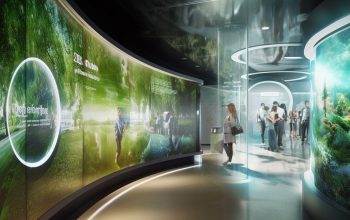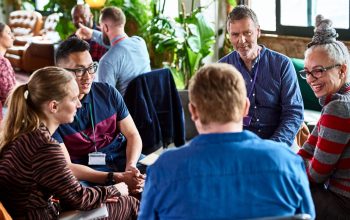Let’s be honest. The word “networking” can send a shiver down many a spine. For some, it conjures images of crowded, noisy rooms, the pressure to make small talk, and the exhausting performance of being constantly “on.” Now, imagine navigating that environment if your brain processes sensory input, social cues, and communication in a fundamentally different way.
That’s the reality for many neurodivergent individuals—those with ADHD, autism, dyslexia, and other neurological variations—in traditional workplace settings. Standard networking practices aren’t just awkward; they’re often a barrier. A solid wall where a bridge should be.
But here’s the deal: neurodiversity isn’t a problem to be solved. It’s a vast, untapped resource of creativity, pattern recognition, and innovative thinking. Building neurodiversity-inclusive networking practices isn’t about charity. It’s about building a smarter, more resilient, and genuinely connected organization. Let’s dive in.
What Do We Mean by Neurodiversity-Inclusive Networking?
At its core, it’s about shifting the responsibility for connection from the individual to the environment. Instead of expecting everyone to adapt to one rigid social script, we create multiple pathways for people to build relationships, share ideas, and advance their careers. It’s moving from a monologue to a dialogue—or better yet, a multi-logue.
Think of it like this: if you only communicate by speaking aloud, you exclude those who use sign language. Inclusive networking simply acknowledges that there are many different, equally valid “languages” of professional connection.
Rethinking the “Mixer”: Alternatives to High-Stakes Social Events
The classic after-work drinks or large conference can be a sensory and social minefield. Overwhelming noise, bright lights, and the expectation of spontaneous conversation can be debilitating. So, let’s get creative with our networking event ideas.
Structured, Low-Pressure Gatherings
Replace the free-for-all with an activity that provides a natural focus. A structured workshop, a collaborative problem-solving session, or a “lunch and learn” with a clear agenda gives people a shared purpose. The activity becomes the conversation starter, removing the pressure to invent one from scratch.
Interest-Based “Pods” or Groups
Facilitate the formation of small groups based on shared interests—be it a specific technology, a niche hobby, or a professional skill. These smaller, more intimate settings are often less intimidating and allow for deeper, more meaningful connections to form naturally.
Quiet Zones & Sensory Considerations
For any larger gathering, always provide a quiet, low-stimulation room where people can retreat to recharge. It’s a simple accommodation that signals profound respect for different sensory needs. Honestly, it’s a welcome respite for just about everyone by the end of a long day.
The Digital Water Cooler: Asynchronous and Online Connection
The rise of remote and hybrid work has, ironically, been a boon for neurodiversity-inclusive networking. Asynchronous communication tools allow people to contribute on their own time, when their energy and focus are at their peak.
Encourage the use of platforms like Slack or Microsoft Teams not just for work, but for low-stakes social channels. A #gardening channel, a #pet-photos thread, or a space for sharing interesting articles can foster community without demanding immediate, in-person interaction. It’s networking without the performance anxiety.
Communication & Mentorship: Clarity is Kindness
A huge part of networking is the unspoken rules. The subtle dance of who to approach, when to speak, and how to “sell yourself.” For neurodivergent individuals, these rules can be completely invisible. The solution? Make everything explicit.
Providing Clear Agendas and Expectations
Before any networking event, share a detailed agenda. List the goals, the structure, and even suggested conversation starters. Let people know if they’ll be expected to introduce themselves to the group. This foreknowledge reduces anxiety and allows everyone to participate more fully.
Formalizing Informal Connections
Instead of hoping mentorship happens organically, create structured mentorship and sponsorship programs. Pairing junior and senior employees with clear objectives and meeting frameworks ensures that valuable guidance isn’t only available to those who are naturally outgoing or socially adept.
Small Shifts, Big Impact: Daily Inclusive Practices
Inclusive networking isn’t just about events. It’s woven into the fabric of the everyday. Here are some simple, powerful adjustments any team can make.
| Instead of This… | Try This Inclusive Alternative |
| Cold-calling on people in meetings | Sharing questions in advance and using a “raise hand” feature or chat |
| Vague feedback like “be more proactive” | Specific, actionable feedback with clear examples |
| Assuming a handshake is welcome | Offering a verbal greeting or a wave |
| Requiring camera-on video calls | Making video optional and normalizing audio-only participation |
Beyond Accommodation: The Tangible Benefits
Fostering an environment of psychological safety and inclusive professional development isn’t just the right thing to do. The data backs it up. Companies that embrace neurodiversity report gains in innovation, problem-solving, and employee engagement. You’re not lowering the bar; you’re widening the talent pool and discovering new ways to clear it.
When people don’t have to exhaust themselves masking their true selves to fit in, they can pour that energy into their work. They can connect based on shared interests and complementary skills, not just social mirroring. The result? A richer, more robust, and honestly, more interesting professional community.
A Final Thought: The Goal is Connection, Not Conformity
The ultimate aim of neurodiversity-inclusive networking practices is to move away from a one-size-fits-all model. It’s about designing a workplace ecosystem with multiple on-ramps for relationship-building. It asks us to be more intentional, more explicit, and more compassionate in how we foster professional communities.
The most powerful networks aren’t the loudest ones. They’re the most diverse—a tapestry of different minds, communicating in their own unique ways, and building something stronger together than they ever could alone. The question isn’t whether your neurodivergent employees can network. It’s whether your workplace is ready to listen, and connect, in all the ways they already do.




